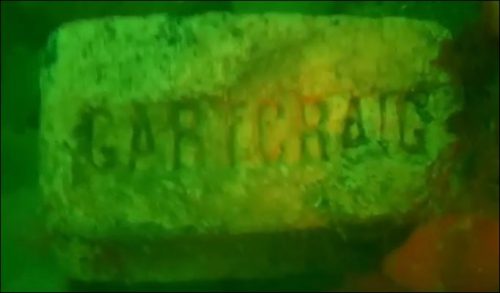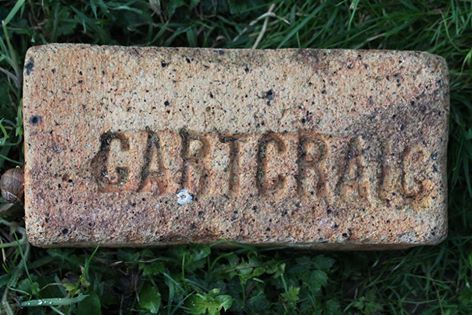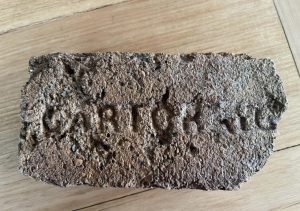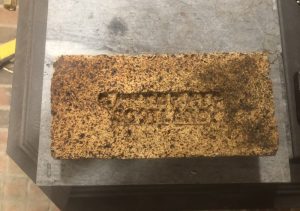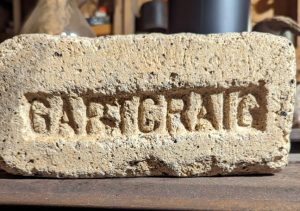30/01/1894 – SV Loch Shiel sinks at Milford Haven, Wales.
1.277 ton fully-rigged iron sailing ship, built 1877. 225ft x 36ft. Cargo: 7000 cases of whisky, bottled beer, general. Brick ballast. Glasgow for Adelaide.
Sunk: 30 January 1894, ran ashore on Thorn Island while seeking shelter from a gale in Milford Haven. The heroic rescue of all 33 aboard by Angle lifeboat.
Builder – Henderson D& W & Co Ltd, Meadowside – D & W Henderson’s Meadowside Shipyard was originally developed by Tod & MacGregor. David and William Henderson, who owned a marine engineering works in Finnieston, bought the yard in 1873. The Henderson brothers were also partners in the Anchor Line, for whom they built thirty-two ships between 1876 and 1911, as well as undertaking considerable repair work.
Owner – Glasgow Shipping Co-General Shipping Co, Loch Line (William Aitken & James Lilburn)
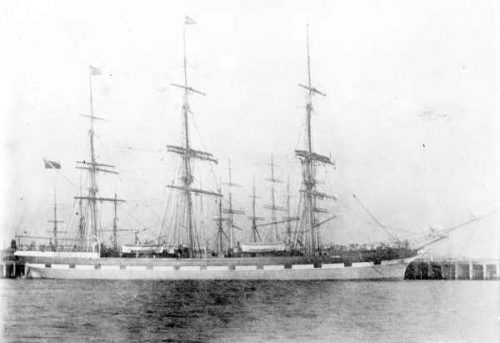
26 – 27/02/1894 – Enquiry into the sinking. (No. 4879.) “Loch Shiel” The Merchant Shipping Acts, 1854 to 1887.
IN the matter of a formal Investigation held at Glasgow, on the 26th and 27th days of February 1894, before Mr. Sheriff Guthrie, assisted by Captains Cosens and Bigley, into the circumstances attending the stranding of the British sailing ship “Loch Shiel” of Glasgow, on or near Thorn Rock, Milford Haven, on the 30th ultimo.
Report of Court. – The Court, having carefully inquired into the circumstances attending the above-mentioned shipping casualty, finds, for the reasons stated in the annex hereto, that the casualty was caused by the neglect of the master to verify his position from time to time by cross bearings or otherwise, consequently, believing himself to be round Thorn Rock, he ported his helm too soon.
The Court found the master only in default, but in respect of his high character during a long period of service, suspended his certificate for three months only. His certificate of competency as master, No. 33,321, was stated to have gone down with the ship.
Dated this twenty-eighth day of February 1894. (Signed) W. Guthrie, Judge. We concur in the above report. (Signed) William Cosens, WM. Barnett Bigley, Assessors.
Annexe to the Report.
This inquiry was held at the Glasgow Court House, before Sheriff Guthrie, on the 26th and 27th February 1894, when Mr C. D. Donald represented the Board of Trade, Mr Wylie appeared for the owners, and Mr H. B. Fyfe for the master.
The “Loch Shiel,” official No. 78,568, was a full-rigged iron sailing ship, built at Partick on the Clyde by Messrs. D. and W. Henderson and Co. in 1877. Her dimensions were as follows: length 222.3, breadth 35.65, depth 21.15, gross tonnage 1,277.32, register 1,218.04. She was registered at the port of Glasgow and owned by Mr James Lilburn and others, Mr James Lilburn, of 80, Buchanan Street, being the designated managing owner.
The “Loch Shiel” left Glasgow on January 12, 1894, bound to Adelaide and Melbourne with a general cargo of about 1,600 tons, and with a crew of 27 all told, and six passengers. Her draught of water on leaving the tail of the bank was 18.6 forward and 19 aft. The vessel appears to have been in good condition and properly equipped for the voyage. She had four compasses, placed as follows: one pole on top of the after house, by which the courses were set, one standard on the same house, one aft on the poop to steer by, and one tell-tale in the cabin skylight. She had four boats, two of which were life-boats. She had five life-buoys and 40 life-belts, all of which were kept in a place accessible to the crew.
The “Loch Shiel” lay at the tail of the bank, wind-bound until the 18th. Strong westerly and south-westerly gales having been experienced, the captain put into Belfast Loch and remained at anchor there for three days.
When the weather had moderated, she put to sea again on the 23rd. Adverse winds, increasing to gales, and the heavy sea again prevailed. On the afternoon of January the 30th, the vessel then being 15 to 20 miles S.W. by W. of the Smalls, the master decided to run for Milford Haven for shelter, and thereupon steered a S.E. 1/2 E. course by the pole compass for St. Ann’s. It was stated in evidence that the compass had no deviation on this course. When the vessel bore up, the sail was increased to whole top-sails and main topgallant sail.
At or about 5 p.m., St. Anne’s Lights were reported one point and a half on the port bow. From this time no special courses appear to have been steered, the master from time to time instructing the man at the wheel as to the position in which he was to keep the lights.
At about 7 p.m., after rounding St. Anne’s, the Castle Head Lights were sighted and reported 1 1/2 points on the port bow. The course was then altered to bring the lights in one, the man at the wheel being instructed by the master to keep them ahead. The sail was shortened, and the vessel proceeded up the harbour. At about 7.30 p.m. the master ordered the helm to port and brought the vessel’s head round to E. by S. by the pole compass. It was stated in evidence that at or about the time the master ported to haul around Thorn Rock (being under the impression he was out of the red sector of St. Anne’s Lights, which was a guide to clear this danger), a squall came on which obscured the Castle Head Lights, but left St. Anne’s still visible. At about 7.40 p.m., the squall, having passed over, the Castle Head Lights again became visible, and almost immediately afterwards land was reported right ahead, and the cry of “hard-a-starboard” heard from forward. The helm was put to starboard, and the vessel’s head came up to about E. 1/2 N. when she struck upon what proved to be Thorn Island and remained fast. The order was then given to get the boats out, but before this could be accomplished the ship sank by the stern, the sea breaking over her and covering the deck up to the after part of the fore-rigging. The master and six of the crew took shelter in the mizzen rigging, the remainder on the forecastle-head. These latter got over the bows on to the rocks. Those in the mizzen rigging were taken off by the lifeboat from Angel Point Station, which came in response to signals made about an hour after stranding. From the direction of the ship’s head at the time of stranding, and the position of the island where she grounded, it is evident that she must have passed to the southward of the Thorn Rock, and could never have been out of the red sector of St. Anne’s Light.
At the conclusion of the evidence the following questions were submitted for the consideration of the Court, when Mr Fyfe, having addressed the Court on behalf of the master, and Mr C. D. Donald on behalf of the Board of Trade, the Court gave judgment as follows:
1. Whether proper measures were taken at or about 4.30 p.m. of the 30th January, and from time to time thereafter to ascertain and verify the position of the vessel?
2. Whether proper courses were set at or about 4.30 p.m., and from time to time thereafter, whether they were made good, and whether good and proper allowance was made for the tide, currents, and leeway?
3. Whether a good and proper look-out was kept?
4. Whether the total neglect of the lead was justifiable?
5. What was the cause of the casualty?
6. Whether the vessel was navigated with proper and seamanlike care?
7. Whether the master and officers are, or any of them is, in default?
In the opinion of the Board of Trade, the certificates of the master and officers should be dealt with.
Answers.
1. Proper measures were not taken at about 4.30 p.m. of the 30th of January, nor at any time thereafter.
2. A proper course was set and steered from 4.30 p.m. until about 5 p.m. when the St. Anne’s Lights were sighted; after this, no special courses appear to have been set. The master stated that he from time to time instructed the man at the wheel as to the position in which he was to keep the leading lights. Proper allowance appears to have been made for the tide.
3. A good and proper look-out was kept. The Court regrets not having had the advantage of the look-out-man’s evidence.
4. The total neglect of the lead was not justifiable in the case of a sailing ship entering Milford Haven at night.
5. The casualty was caused by the neglect of the master to verify his position from time to time by cross-bearings, or otherwise, consequently, believing himself to be round Thorn Rock, he ported the helm too soon. The Court is of opinion from the position in which the vessel grounded, and the direction of her head at the time, that she must have passed to the southward of the Thorn Rock.
6. The vessel was not navigated with proper and seamanlike care.
7. The master alone is in default.
(Signed) W. Guthrie, Judge. William Cosens, WM. Barnett Bigley, Assessors.
*******************************
13/05/1894 – Evening News – Smuggling extraordinary – Spirits and beer in all directions in Pembrokeshire.
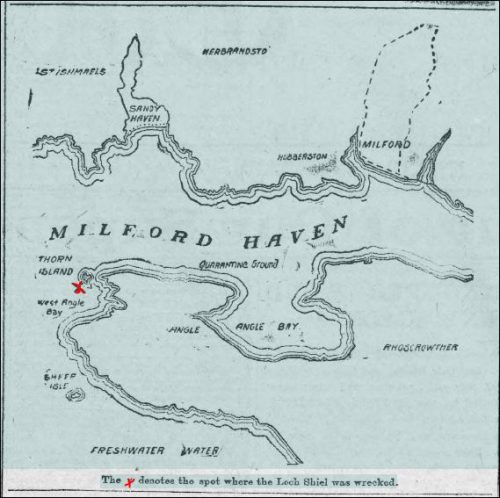
With reference to the announcement in the “Evening Express” of Tuesday of the alleged smuggling of salvaged goods belonging to the Loch Shiel, a Glasgow ship, which went ashore o Thorn Island, off Milford Haven, and the romantic seizure by the Customs officers in the course of their search for the missing contraband goods, our reporter has been making further inquiries into the matter, and has made some startling discoveries. Writing from Milford Haven on Tuesday evening with reference to the matter, he says:-Some extraordinary scenes have been witnessed and strange things done, but the secrecy practised and the reticence since maintained enables one to have but very slight glimpses indeed of what has recently taken place on the shores of Milford Haven. Enough, however, has come to light to show the disgraceful character of the whole proceedings. The country round here, to use a very expressive phrase employed by a gentleman with whom I had a conversation today, is inundated with whisky. There were nearly 7,000 cases, as already stated on board the Loch Shiel, but only 2,000 has so far come to the hands of the authorities. The remaining cases and casks have gone in all directions, from Dale to Milford Haven, from Angle to Castle Martin. Almost every cottager and farmer is able to indulge in a steaming glass of whisky punch, rewed, too, not in the local public-house, but on the domestic hearth. Certain Castle Martin farmers, than whom one can never meet a more jolly lot, on the whole, have been heard to make the boast that they have tasted each particular brand of the whiskey, and they have, with some sense of humour, christened the said whiskey “Special Angle,” on account, it s to be presumed, of its having been procured from that village.
“The whiskey trade in these parts has been ruined for a time,” lamented a gentleman to me this afternoon, and he added facetiously, “if such wrecks as that of the Loch Shiel occurred in any frequency, Sir William Harcourt and his system of finance must go to the wall.”
To prove the truth of this, I may repeat what I was told on the very credible authority, namely, that the revenue of the district has fallen off to the extent of something like £500. Of late the means adopted to carry out this magnificent system of plunder has not been altogether unknown to the authorities. By night, as well as by day, boats were sailing up and down the harbour and picked up what could be laid hands on. If by chance the looters came across any of the Customs officers or the police, they straight away delivered up the goods and claimed the usual percentage allowed for salvage. Pretty much the same course was followed onshore, a person carrying the contraband spirits would on meeting an official declaring he was going to hand it over to the Custom-house authorities, in most circumstances, however, this proceeding was not followed, and accordingly the whiskey was conveyed to a place of safety and secreted. One naturally inquired whether due precautions had been taken by the authorities, or whether it was impossible to watch all the cases that came ashore. there were boats of every description employed. Wherever a boat could be got it was used for salving. It was a singular thing the sympathy of the whole population seems to be against the Revenue officers. People seem to think it an honourable thing to cheat the Government. there never was much plundering at Milford, but it is not only at Milford and at the places on the shores of the haven the thing is connived at. At Haverfordwest, for instance, which is some distance from here, whiskey from the wreck has been sold at a shilling a bottle. Of course, it is more profitable for them to sell it at a shilling a bottle than bring it to the Customs authorities and get the salvage percentage.
In the course of further investigation with other gentlemen, I gathered the smugglers arranged things so well that it is now almost impossible to obtain sufficient evidence to proceed against them in a court of law. Legal proceedings will, however, result in the discovery of the whiskey hidden in a fisherman’s garden at Gellyswick. But if sufficient evidence s not procurable to bring home the guilt of the smugglers to the satisfaction of a court of justice the ill effects of the whiskey on the inhabitants has been obvious enough. Men could have been helplessly drunk on-field and cliff and in their own houses. Not being on the highway they could not, of course, be proceeded against. Bu this is not the most serious side of the picture. Death itself followed in at least one instance, and too free an indulgence in the stole liquor is supposed to have been in some degree responsible for the morality of three more. In the case where death was directly attributed to excessive drinking, a young man, named William Taylor, of Herbrandston, was the victim. He found the whiskey on the shore, ad, in company with his brother, partook of the raw spirits to such an extent that he died in a field. It is a matter of little disputed that by far the greater portion of the whiskey has found its way to Angle and that part. Here large quantities have been sold to farmers and others, and things have, it is said, come to such a pass in the village that the men fight for the whiskey, and even steal that belonging to their neighbours. Since the seizure made by the authorities, the Angle folk have become doubly wary, and those who have illicit stuff hidden on their respective premises-and it is a notorious fact that there is a great deal of whiskey still secreted there-are on a constant look-out for the appearance of the authorities.
The Customs House authorities have naturally come in for criticism in connection with the whole affair. After the wreck took place it appears, they were engaged, without rest or intermission, in taking account f the vessel, but no credence seems to have been given to the reports which must have gone about of plundering people. The action of the authorities, it is contended, now savours very much of the conduct of the man in the proverb, who shut the stable door after the steed had been stolen. Several attempts have lately been made to trace some of the stolen whiskey, the officers in one instance carrying their operations even to St. Bride’s, where it was reported a large amount of whiskey was secreted. Their visit, however, was not attended by success, for they did not discover the whiskey. Meanwhile, the people of Milford, no less than other parts of the country, are awaiting further development.
**************************************

Below – A still from the above video.




